

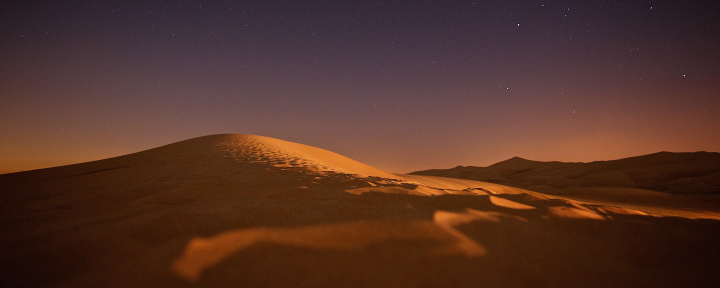
It was the summer of 1990 and broiling hot in southwest Oman. The small group spread out their sleeping bags on a desert mesa, under the setting Sun. They had not planned on stopping here for the night, so they had no radio, nor any mode of communication. Their transport, a Vietnam War-era Huey helicopter, had returned to Thumrait Air Base to refuel, leaving them grounded until morning.
The group was on a quest to find the ruins of an ancient, remote outpost—a destination that would have taken days to reach by camel. This was a reconnaissance mission, their first to the desert of Oman.
The team was an unlikely one. There was George Hedges, an entertainment industry lawyer from Los Angeles; Sir Ranulph Fiennes, a British baronet and explorer; and Juris Zarins, an archaeologist. Their ringleader was documentary filmmaker Nicholas Clapp, accompanied by his wife Kay, a federal probation officer. Then there was Ron Blom, a geologist and remote sensing specialist from NASA’s Jet Propulsion Laboratory.
Between them, they had a large duffel containing some old military-supplied “meals-ready-to-eat,” archaeological sample bags, and a small pickaxe—the sort used to pry artifacts loose from clay. A handful of Omani soldiers came along for protection in the country’s tribal territories. For navigation, they mostly relied on compasses and grainy satellite images; civilian-grade GPS systems were still an inconsistent novelty.
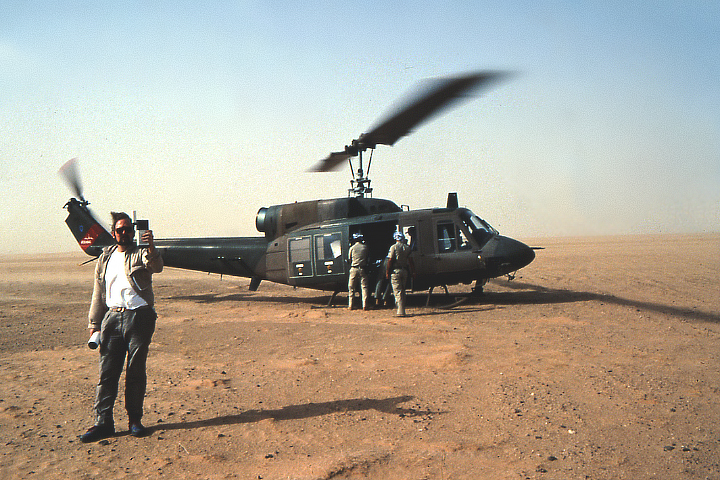
NASA scientist Ron Blom holds an early model GPS receiver while trying to find his position in the desert of Oman. (Photo courtesy of Ron Blom.)
“The only guys who knew where we were were the helicopter pilot and co-pilot,” Blom recalled later. “I was thinking this could go very bad.”
It was an early step in an unlikely search for the long-lost trading post at Ubar, a mythic place that once teemed with wealth and lavish feasts. But it was also the start of something bigger: the revolution of a scientific field.
For centuries, if archaeologists wanted to find an ancient or mythical site, they trudged through desert sands or rainforest thickets armed with little more than rumors and hand-drawn maps. They worked from historical accounts and biblical texts and a lot of educated guesswork.
But all of that changed in the late 20th century when some of them began using a new tool: remote sensing. By gathering data and images from satellites and aircraft, researchers began to uncover a wealth of new finds. Like the glow of a flickering bulb, images taken from above were shedding light on previously dark landscapes.

The Shuttle Imaging Radar-A acquired this view of southern Egypt in 1981. Radar pulses allowed the sensor to detect subsurface features—such as the dry stream channels shown here—beneath the sand. While promising, such early images from space were dark, grainy, and difficult to interpret. (Image from NASA/JPL.)
Michael Harrower started working in the field in the 1990s, as the first recreational GPS systems became publicly accessible. Now an archaeologist and professor at Johns Hopkins University, Harrower grew up in his field as it was starting to turn to satellites for answers. Like many of his colleagues, he has grappled with a vexing question: “If you don’t have a very good sense of where you’re going and where you’ve been, how do you mark what you’ve found?” Harrower and his peers were looking for a tool that could show them the very literal “bigger picture.”
As satellite imaging—natural-color, false-color, and radar—evolved and became more accessible, a scientific community that had once measured the rise and fall of civilizations based on a few archaeological dig sites was suddenly turning up features hundreds or thousands of kilometers long. “We started seeing archaeology problems as geographic problems,” Harrower said.
By looking down from above, archaeologists can survey thousands of kilometers of a landscape from home and they can start to investigate potential dig sites without actually digging. They can even search next to existing archaeological sites for evidence of other hidden structures.
With remote sensing to fill in what human eyes could not see, archaeologists unearthed a number of previously undetected sites. For instance, airborne sensors removed the dense veil of jungle vegetation around Angkor Wat, Cambodia, revealing a vast urban landscape and elaborate water infrastructure between temples. In Tanis, Egypt, satellite sensors pierced the shroud of desert sands, unmasking structures covered by centuries of deposition.
For many modern archaeologists, remote sensing tools have become as valuable as carbon dating. But it wasn’t always this way. Space archaeology developed over several decades, as it took a long time for Space Age tools to gain acceptance in one of the oldest scientific fields.
“Can I please speak with someone who can help me find a lost city?”
This, more or less, was the question Nicholas Clapp posed to a telephone operator at NASA’s Jet Propulsion Laboratory in 1983. The operator put Clapp through to Ron Blom.
For months, Clapp had leafed through ancient manuscripts and historical accounts searching for any mentions of Ubar. On a chart, he had marked possible locations for the lost oasis that survived in legends, sometimes by the name Ad, other times as Iram. It had been luxurious, a place that one pre-Islamic poet described as filled with “the glow of fiery wine” and the aroma of roasting meat, with “statue-like” women who wore robes hemmed in gold.
The site had gained importance with the rise of frankincense, the fragrant resin of a tree native to southern Arabia. In the ancient world, that resin was used to make incense for religious ceremonies and medical practices. From the time the city rose—roughly 2,000 years ago, according to estimates—until its fall between 300 and 500 CE, Ubar grew wealthy as an outpost of the frankincense trade.
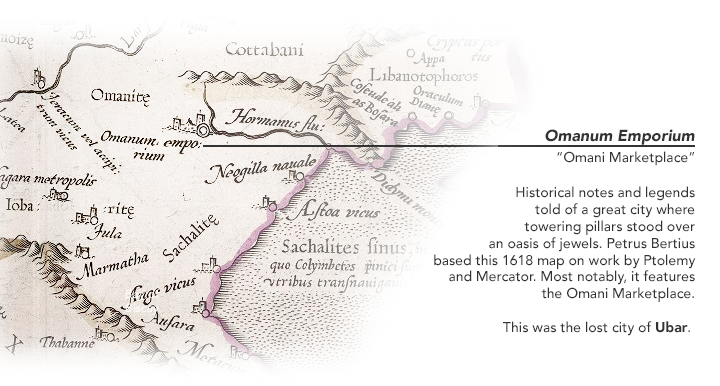
The oasis, however, was not to last. According to legends, the people of Ad (Ubar) behaved wickedly, provoking divine punishment. “When morning came there was nothing to be seen besides their ruined dwellings. Thus we reward the wrongdoers,” reads an account from the Quran. The city was brought down by a “hurricane bringing a woeful scourge.”
The site was mentioned in historical accounts from Greek geographer Claudius Ptolemy and British explorer Bertram Thomas. Though Ptolemy’s maps no longer remain, his notes make reference to a place he called “Omanum Emporium.” And Thomas, who traveled through the region in the 1930s, plotted its rough location on a map, intending to search for it by camel.
To verify the historic and mythical claims, Clapp needed a tool that could see through the sand. NASA had such a tool.
Around the same time that Clapp picked up the phone to call JPL, engineers were preparing the Shuttle Imaging Radar-B (SIR-B) for a flight on the space shuttle Challenger. Its radar signals would be able to penetrate cloud cover, vegetation, and dry sand to reveal hidden features in the landscape. Blom had been a principal scientist on the instrument’s precursor, SIR-A, which flew on a 1981 mission aboard Columbia. That instrument had discovered unprecedented underground details in the Selima sand sheet, a vast expanse of desert in Egypt.
By the time Clapp called him, Blom had already become accustomed to fielding odd requests. “We got a lot of strange phone calls after our work in Egypt, most of them along the lines of ‘my grandmother buried some treasure in the back of lot forty and we want you to help us find it.’” But he gave this caller a chance. “Nick clearly knew his stuff. He was not one of the mad crowd.”
A week after his first chat with Blom, Clapp had his entré: a meeting with Charles Elachi, the principal investigator of NASA’s SIR-B project.
“I remember him saying, ‘Okay, let me get this straight: You want to use my spaceship to find your lost city?’” Clapp recalled. “And I said, ‘That’s it.’”
Elachi agreed to do it. As long as Ubar would not distract from the main SIR-B mission, they would pursue this “target of opportunity.” The radar would take images of the Omani desert.
Orbiting 100 miles above the Earth, a handful of satellites periodically ejected film capsules that fell through the sky with little parachutes trailing behind them. Swooping in like a hawk, an airplane caught them in mid-air. It was the 1960s, and the Cold War was in full swing.

Airplanes snagged capsules of reconnaissance photos as they dropped from Corona satellites to Earth. (Photo courtesy of the United States Air Force.)
Taken by the first U.S. spy satellite program, the high-resolution images in those canisters showed Soviet military bases and strategic installations. But the Corona satellite images also captured much more. They unintentionally acquired the building blocks of space archaeology.

Members of the Air Force and two civilians stand next to the first successfully recovered Corona capsule. (Photo courtesy of the United States Air Force.)
“You can always go somewhere, but you can’t go somewhen,” said Ron Blom in a May 2016 lecture at the California Institute of Technology. With Corona imagery, archaeologists can go “somewhen” and peer at the world as it had looked half a century ago. Corona captured what are the oldest “pictures of areas that are now changed considerably.”
Collected between 1960 and 1972 and declassified in 1996, the Corona images have become a treasure trove for archaeologists. For some countries, the images are the only remaining clues to landscapes that have since been bulldozed, bombed, or redeveloped. Scientists from the Australian National University used the old spy images to locate ancient dwellings, pottery factories, and tombs in Syria. Researchers at Harvard University have used them to find Mesopotamian traveling routes in modern-day Iraq and Syria.
On October 5, 1984, the launchpad at Cape Canaveral roared to life as the space shuttle Challenger thrust into the sky. The crew was about to make—and find—history. The seven-person crew was the largest ever to fly on a single spacecraft, and it was the first space flight to include two female astronauts. For Clapp and Blom, it was significant for another reason: It was to be the first time a spacecraft would explicitly search for an archaeological site.
But eight days after the launch, Charles Elachi spoke to the media: “The lost city will have to be lost for another year or so.” SIR-B had achieved just 40 percent of its goals due to a faulty antenna. An issue of Time magazine reported that some scientific projects had to be sacrificed, including the images of the Arabian Peninsula.
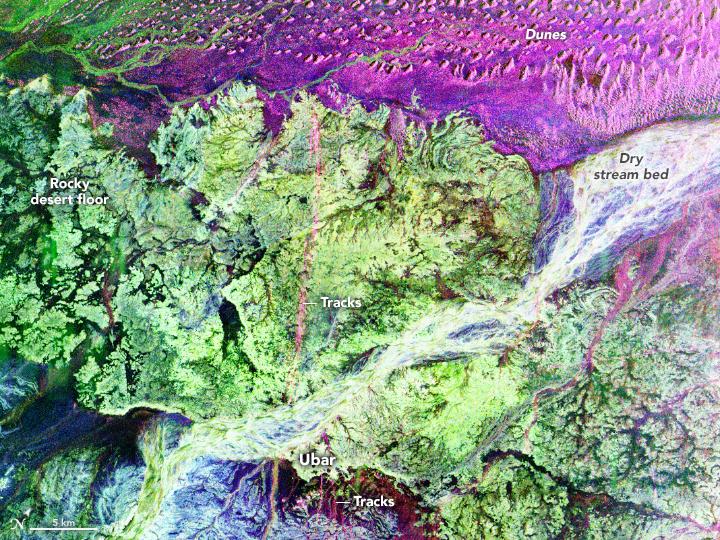
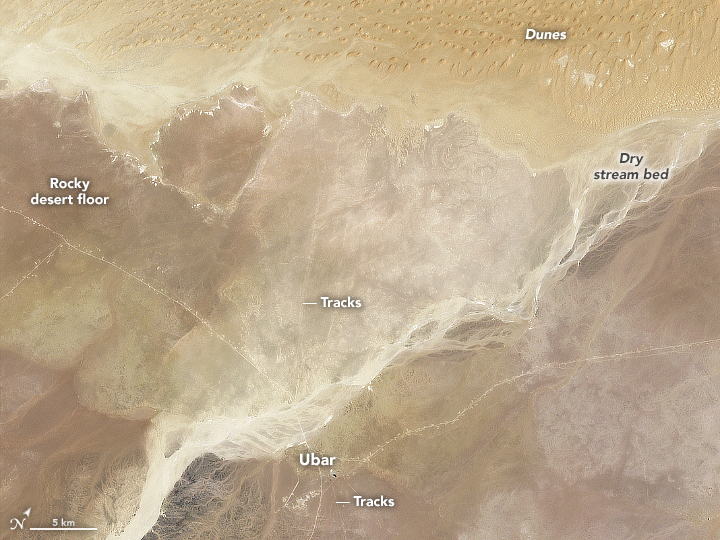
A comparison of images from 1994 shows how radar imagery can reveal features that are mostly undetectable in visible light. (NASA image (left) courtesy of JPL. NASA Earth Observatory image (right) by Joshua Stevens, using Landsat data from the U.S. Geological Survey.)
Then, in the spring of 1985, in a windowless room at JPL, Blom opened a manila envelope containing several black-and-white images on clear plastic. One of them bore the title “JPL Data Take 96.1.” SIR-B had, after all, captured some of the landscape Clapp was hoping to see.
Radar imagers send out pulses of radio waves and collect the return signals (like echoes) after the waves bounce off of surfaces on the land and sea. The smoothness, roughness, and density of a surface all affect what the instrument can “see” in the return signal. Unlike optical instruments, which can only see the surface, radar can penetrate some materials. In the case of SIR-A, the signals reached as far as 3 meters (nearly 10 feet) beneath sandy surfaces. The SIR-B radar sent and received images from several angles, allowing researchers to see the terrain with some three-dimensional perspective.
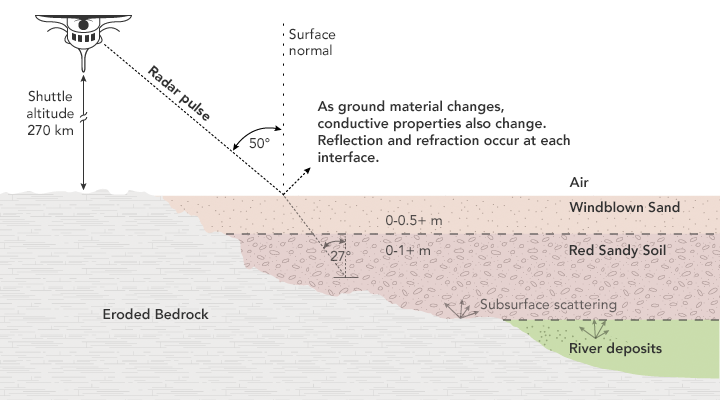
Radar reflects and refracts when the signal meets material at and below the ground. This allowed the Shuttle Imaging Radar to “see” hidden features buried beneath the sands. (NASA Earth Observatory illustration by Joshua Stevens, adapted from material by JPL/USGS.)
Together, Clapp and Blom pored over SIR-B’s observations of the Rub‘ al-Khali, the vast desert known as the “Empty Quarter.” In ancient times, some of this land may have been green and vegetated, resembling a savannah. What Clapp and Blom saw in their radar images suggested that a different landscape lurked beneath the modern sands—a landscape that could have supported human life. They brought a magnifying glass to the images, hoping to spy faint fingerprints of Ubar.
Space archaeology might not have taken off without Tom Sever.
In the late 1970s, while working on a project for an environmental non-profit organization, Sever went to Peru to re-trace paths followed in the 1500s by the Spanish conquistador Francisco Pizarro. It took three months for Sever and a colleague to walk one-and-a-half of the 41 lines. He remembers thinking: “There has to be a better way to do this.”
Sever read an article about imaging work being done at NASA’s Stennis Space Center in Mississippi, and he decided to apply to the program. “Traditional archaeology wasn’t going to work for me to answer the questions I had,” he said. In 1981, he joined the small group of programmers at Stennis who were learning to interpret satellite images even as “NASA was inventing remote sensing.” Archaeologists had only just started to approach the agency for help in surveying sites.
In his first year at Stennis, Sever worked by day scouring imagery to make agricultural maps. But by night, he was chipping away at his passion project: mapping archaeological sites. Using several tools—the Thermal Infrared Multispectral Scanner (TIMS), the Calibrated Airborne Multispectral Scanner (CAMS), and the Advanced Terrestrial Land Applications Sensor (ATLAS)—he charted Chaco Canyon, New Mexico, home to the highest concentration of pueblos in the southwestern United States. Poring through images, Sever found ancient roadways that let to sacred sites—roads 30 feet wide and “straight as an arrow.” Fieldwork by ground-based teams verified the finds. “It was ten for ten.”
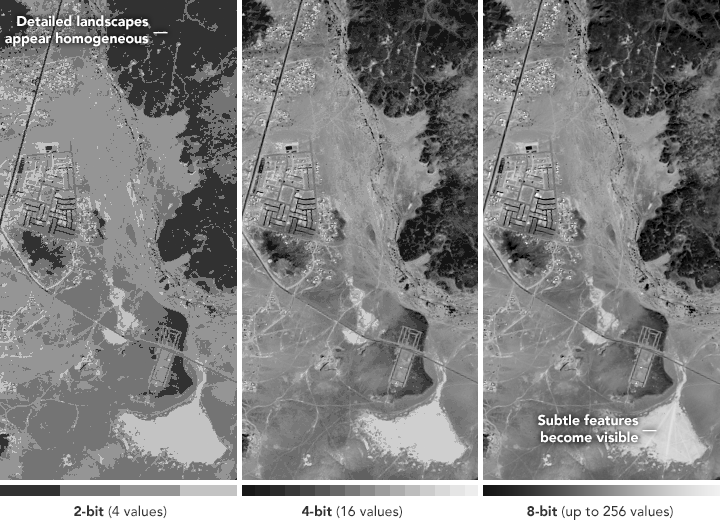
Advances in remote sensing technology have significantly improved satellite imagery. Among the advances were improvements in radiometric resolution—or how sensitive an instrument is to small differences in electromagnetic energy. Sensors with high radiometric resolution can distinguish greater detail and variation in light. (NASA Earth Observatory images by Joshua Stevens, using Landsat data from the U.S. Geological Survey.)
In 1984, two dozen archaeologists came to Stennis to learn about advances in NASA’s remote sensing technology and the possible applications for their field. Sever was ready with stories of his Chaco work. By the time the conference was over, doubts gave way to enthusiasm. “It also seemed clear that the basic archaeological survey, at least, would in the future be radically altered,” wrote James Wiseman, Sever’s colleague from Boston University.
Space archaeology would eventually become Sever’s full-time job. In his three decades at NASA, other sensors would slowly fill out the remote sensing toolkit. Perhaps the most important was Landsat, a partnership between NASA and the U.S. Geological Survey. Whereas airborne sensors relied on data collected on sporadic and limited flights, Landsat provided continuity with new digital images collected from the same angle every 16 days. Over the decades, the resolution of Landsat imagers improved from 79 meters to 30 meters to 15 meters per pixel, allowing researchers to see many more details far more frequently.
“If you have a black-and-white photo of your grandmother, you can only see 10 to 12 shades of gray,” Sever said. In contrast, the first satellites had 64 shades of gray in four bands. “Today we’re talking about sensors that have 12-bit data. That means 4,096 shades of gray...and that’s just in one band.”

Ron Blom studies a satellite image—one he hopes will lead him and his team to Ubar. (Photo by Nicolas Clapp.)
Under a gray dawn sky in 1993, Nicholas Clapp trained his camera on Ron Blom as the scientist unfurled a poster-sized satellite image across the hood of a car. Blom traced his finger along the image, finding a path between the enormous sand dunes of the Rub‘ al-Khali. Behind him, the towering forms of the real dunes loomed.
Blom turned to the instrument in his hand, an early GPS receiver. It showed no signal. He had expected this, as it could acquire a signal just once a day—during a half-hour window in the early morning when GPS satellites passed over the area.
The quest for the ancient city of Ubar was still hindered by technology, awaiting tools not yet commonplace. The satellite imagery Blom was carrying largely resembled its Corona-era precursors: grainy and mostly black-and-white. “You had to do everything by inference,” said Blom. “The structures were barely visible.”
Travel across the barren, sand-strewn landscape required careful calculation, and the explorers made frequent stops to check their location. Blom would ask himself: does the landscape look like it should? On the map, a series of marks indicated their progress. “In those days, the image data wasn’t geo-located,” Blom said. “Basically, it was a compass and dead reckoning.”
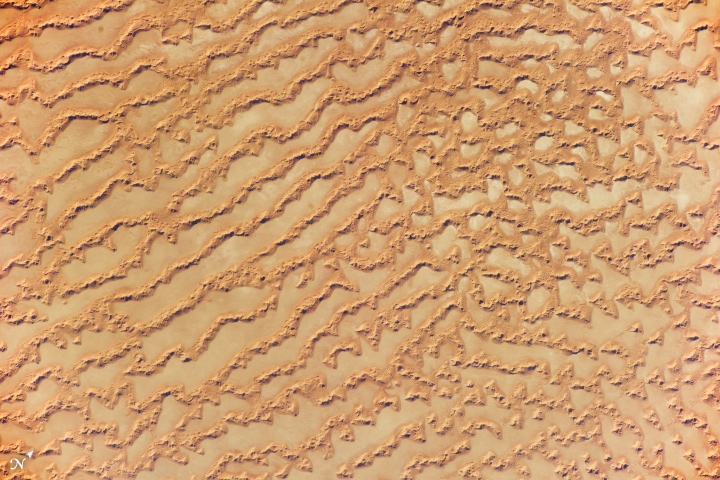
From space, the vast Rub‘ al-Khali stands out as a sea of sand, where towering dunes take the place of waves. (Astronaut photograph.)
A bumpy ride across the Omani desert led the team to one of the few inhabited spots in that vast sandscape: a seasonal settlement of the Rashaida bedouin. Nearby, in the glare of the sunlight, there stood a hill. It was all that remained of ancient Shisur, an oasis that had once quenched the thirst of travelers and their camels. It was a rest stop on the road to Ubar, the team thought.
“We were at that point a little quietly desperate in that this was the last possibility,” Clapp said. “We had eliminated everything else.”
The team pitched camp. They would dig for a month.
With the development of airborne light detection and ranging (lidar), archaeologists gained perhaps their most powerful tool. Lidar works by sending out laser pulses of light to measure the distance to a land or ice surface. Suspended from a plane or helicopter, the tool can generate precise elevation data that allows researchers to build three-dimensional maps of a landscape.
“Lidar allowed us to see how big sites are, and that takes you in different directions,” said Arlen Chase, an archaeologist at the University of Nevada, Las Vegas. Chase and his wife, archaeologist Diane Zaino Chase, have been conducting excavations in Mesoamerica for more than 30 years. Early adopters of lidar, they have uncovered thousands of ancient Maya artifacts and made several important discoveries, including Altar 21—which recorded the defeat of the ruling Tikal dynasty by the citizens of Caracol—and royal tombs that date back to 537 C.E. Lidar maps helped them detect the outlines of sites that were covered by thick jungle vegetation and otherwise invisible to the naked eye. The imagery also overturned archaeologists’ understanding of the ancient city.
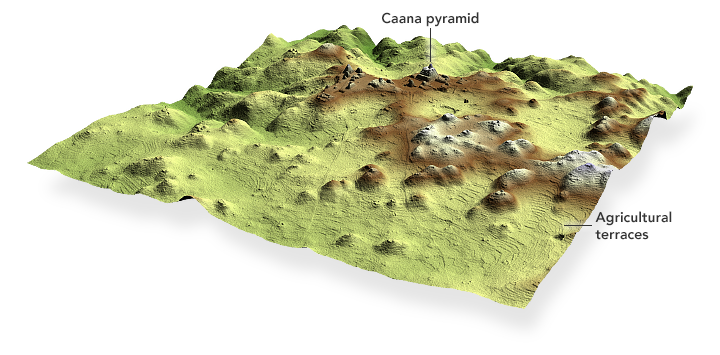
Lidar can reveal an exceptional amount of detail that is usually hidden beneath dense, jungle canopies. This map shows ancient Maya sites around Caracol. (Visualization courtesy of Arlen and Diane Chase.)
“For years we argued that Caracol was a huge city, and everybody else basically said, ‘No, that can’t be. That’s not how Maya sites operate,’” Arlen Chase said. But the Chases’ lidar-assisted observations showed more than 1,500 constructed reservoirs—evidence of vast urban sprawl comparable to that of Belmopan, the modern capital of Belize. Their findings also countered the accepted theory that Maya elites controlled society by regulating access to the water supply. Archaeologists had to build new theories about trade and commerce in the society. “Now we can talk about markets in the Maya area,” Chase said. “Our whole perspective of complexity has changed.”
“Before lidar, these jungle areas were completely unknown to archaeologists,” said Michael Harrower. “You’d need an army of people with buzz-saws to go through the jungle.”
Lidar images can be spectacular, but they are often very costly, so they have remained beyond the means of many researchers. While the technology is becoming cheaper and more widely available, Landsat and similar surface imagers provide the advantage of being freely available on the web.
A wall emerged, and then the semicircles of towers.
After a team of students and volunteers arrived to help, the excavation at Shisur grew into a full-blown archaeological dig. The structure that Zarins, Clapp, Blom, and company uncovered was far larger than they had initially thought—and far older.
In the team’s final week at the site, they used a helicopter to survey the area. From above, the citadel looked bigger than it felt on the ground. More than a decade of research, a few space shuttle and satellite passes, and months of digging had led them to Ubar. “There was never any 100 percent proof,” Clapp said, “but we had pretty much all we could get without finding an inscription.”
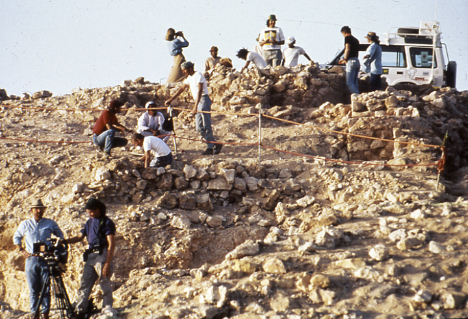
Archaeologists and volunteers busily excavate a site in Oman, revealing a once-sunken fortress in the sand. (Photo by George Ollen.)
Decades later, Ron Blom is less certain. “Taking a flinty-eyed look at it, we just don’t know. Nobody ever found a sign that said ‘the Ubar Chamber of Commerce welcomes you,’” he laughed. It was smaller than the sprawling “lost city” of legend. More likely, it had been a trading post—still impressive in scale and an important find. “Without question, it was the most significant archaeological site in that area.”
In a research paper springing from the expeditions, Blom postulated that trade at Ubar was likely abandoned for three main reasons: “Frankincense diminished in importance with the conversion of the Roman Empire to Christianity; desert groundwater levels continued to fall and the oases dried up; and reliable sea transportation was developed.”

Discovered at last: far from Oman’s modern cities, once-bustling Ubar sits deep in the sprawling sands of Oman. (NASA Earth Observatory map by Joshua Stevens.)
In a sense, the decline of Ubar was both sudden and gradual, a result of human activity and of the relentless hand of Mother Nature. “Over millennia, Ubar’s great well had watered countless caravans and had been drawn upon to irrigate a sizable oasis,” Clapp wrote in The Road to Ubar, his account of the expeditions. “Handspan by handspan, its waters had receded, and the limestone shelf on which the fortress rested became less and less stable.” The very water that had brought life to Ubar had also, literally, helped hold up the foundations.
And then, one day, Ubar came crashing down. “It was likely initiated by a minor tremor, an echo of a faraway earthquake. Yet the seismic shock that hit Ubar was enough to crack and split the limestone underlying the main gate,” wrote Clapp. “As in its myth, the city had sunk into the sands.” The fortress likely collapsed into a sinkhole.
Three decades after the work started at Ubar, remote sensing has evolved from a niche concept to a widely used tool for archaeology. In many ways, this progression recalls a shift in Blom’s other field: geologists were very slow to accept the theory of plate tectonics, which sprouted while he was still a student in the 1960s and 70s.
“The transition in the paradigm took place over realistically about a decade. Everybody thought this was a goofy idea that only a handful of nutcases were interested in. And then this flood of geophysics data comes in and shows what’s really going on,” Blom said. “In a short space of time, you change all geologists and geophysicists into people that believe that plate tectonics changes how the world works.”
Today, remote sensing is indispensable in places like Belize, where Arlen and Diane Chase work. Lidar imagery has become the go-to technology, and Belize’s government has facilitated thorough lidar mapping of the landscape. Colleagues working in other dense, jungle-covered parts of Central America are now acquiring similar data.
But even as remote sensing has aided archaeologists, it could also make their work harder. When the Chases arrived at Caracol, they found that someone else had already visited the site. The disruption was visible even from the air. Like Swiss cheese, many sites are riddled with holes.

There are several significant archaeological sites in this image of Chaco Culture National Historical Park. Can you find them? Increasingly available satellite imagery might make the task easier—perhaps too easy, some researchers warn. (NASA Earth Observatory image by Joshua Stevens, using Landsat data from the U.S. Geological Survey.)
“There are hundreds of looters” trenches in a single group—you can pick them out in lidar,” said Arlen Chase. “In another area, you can’t even tell what the buildings are because the looting is so intense.”
At Machu Picchu in Peru, satellites have shown the impact of thousands of human footsteps over the fragile, ancient site. Satellite imagery is now being considered for the sake of managing tourism.
And at Chaco Canyon, where Sever has done much of his work, mining for uranium and minerals has taken place right next to culturally significant sites. Where the mines don’t reach, many existing artifacts have been picked up and taken or moved by tourists who see them as souvenirs.
These archaeologists fear that remote sensing data can do for looters what it has done for scientists: make it easier to find sites invisible to the naked eye. Many people in the field caution against making archaeological data publicly available because it could provide roadmaps for looters.
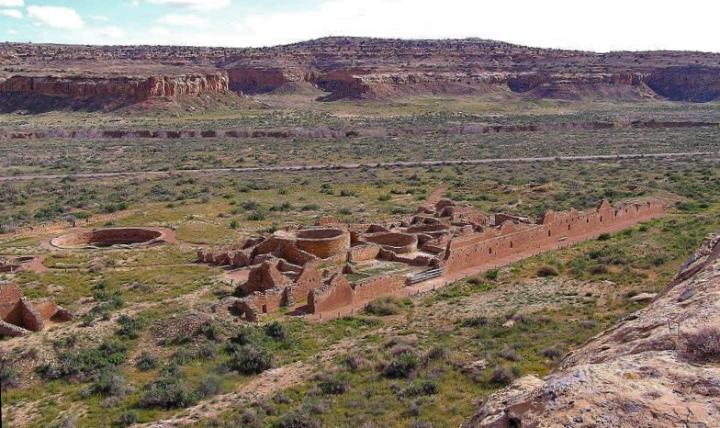
Chetro Ketl, built between 945 and 1070, is a Puebloan great house in Chaco Culture National Historical Park. Many archaeological sites are easily accessible to tourists and the public who know where to find them. (Photo by the National Park Service.)
In a field known for rugged explorers, the pioneers and early adopters of space archaeology increasingly find themselves taking the role of guardians. Even as some archaeologists turn toward more controversial methods like crowdsourcing image analysis, Sever and Chase stress the protection of sites. Remote sensing data, they say, should be closely guarded until sites can be thoroughly examined from the ground.
The rapid pace of urban development, coupled with political instability around the world, lends greater urgency to the need to document landscapes for their archaeological potential. “It’s very important, and it’s only going to become increasingly important,” said Sever. “Not only to express scientific information, but also to monitor landscape modification—to know where things were before they were destroyed.”
Thank you to Compton Tucker (NASA GSFC), Douglas Comer (Cultural Site Research and Management), and Devin White (Oak Ridge National Laboratory) for their contributions to this story.